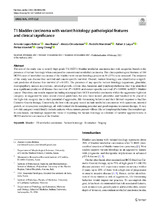Mostrar el registro sencillo del ítem
T1 bladder carcinoma with variant histology: pathological features and clinical significance
| dc.contributor.author | López-Beltrán, Antonio | |
| dc.contributor.author | Blanca, Ana | |
| dc.contributor.author | Cimadamore, Alessia | |
| dc.contributor.author | Montironi, Rodolfo | |
| dc.contributor.author | Luque, Rafael J. | |
| dc.contributor.author | Volavšek, Metka | |
| dc.contributor.author | Chen, Liang | |
| dc.date.accessioned | 2022-05-10T11:04:39Z | |
| dc.date.available | 2022-05-10T11:04:39Z | |
| dc.date.issued | 2022 | |
| dc.identifier.uri | http://hdl.handle.net/10396/22871 | |
| dc.description.abstract | The aim of the study was to stratify high-grade T1 (HGT1) bladder urothelial carcinoma into risk categories based on the presence of variant histology when compared to conventional urothelial carcinoma. The clinicopathological features of 104 HGT1 cases of urothelial carcinoma of the bladder with variant histology present in 34 (37%) were assessed. The endpoint of the study was disease-free survival and cancer-specific survival. Overall, variant histology was identified as a significant predictor of disease-free survival (P = 0.035). The presence of any specific variant histology (squamous, glandular, micropapillary, nested, microcystic, inverted growth, villous-like, basaloid, and lymphoepithelioma-like) was identified as a significant predictor of disease-free survival (P = 0.008) and cancer-specific survival (P = 0.0001) in HGT1 bladder cancer. Therefore, our results support including micropapillary HGT1 urothelial carcinoma within the aggressive high-risk category, as suggested by some recent clinical guidelines, but also favor nested, glandular, and basaloid to be placed in the high-risk category due to their potential of aggressive, life-threatening behavior and their limited response to bacillus Calmette-Guerin therapy. Conversely, the low-risk category would include urothelial carcinomas with squamous, inverted growth, or microcystic morphology, all with limited life-threatening potential and good response to current therapy. A very low-risk category would finally include patients whose tumors present villous-like or lymphoepithelioma-like morphology. In conclusion, our findings support the value of reporting the variant histology as a feature of variable aggressiveness in HGT1 urothelial carcinoma of the bladder. | es_ES |
| dc.format.mimetype | application/pdf | es_ES |
| dc.language.iso | eng | es_ES |
| dc.publisher | Springer | es_ES |
| dc.rights | https://creativecommons.org/licenses/by/4.0/ | es_ES |
| dc.source | Virchows Archiv 480, 989-998 (2022) | es_ES |
| dc.subject | Bladder | es_ES |
| dc.subject | T1 urothelial carcinoma | es_ES |
| dc.subject | Variant histology | es_ES |
| dc.subject | Biomarker | es_ES |
| dc.subject | Staging | es_ES |
| dc.title | T1 bladder carcinoma with variant histology: pathological features and clinical significance | es_ES |
| dc.type | info:eu-repo/semantics/article | es_ES |
| dc.relation.publisherversion | https://doi.org/10.1007/s00428-021-03264-6 | es_ES |
| dc.relation.projectID | Gobierno de España. PI17/01981 | es_ES |
| dc.rights.accessRights | info:eu-repo/semantics/openAccess | es_ES |

